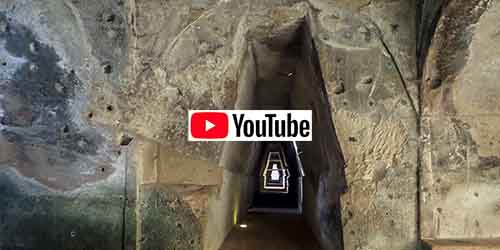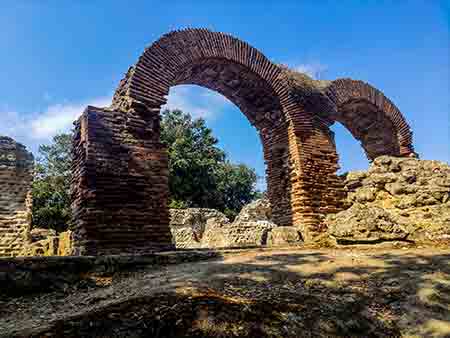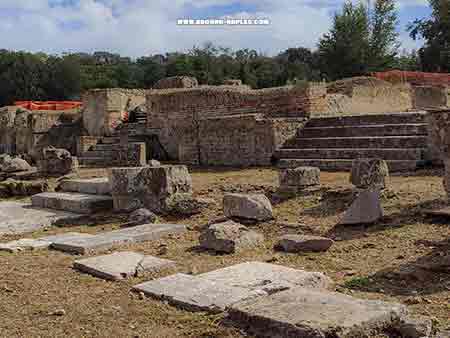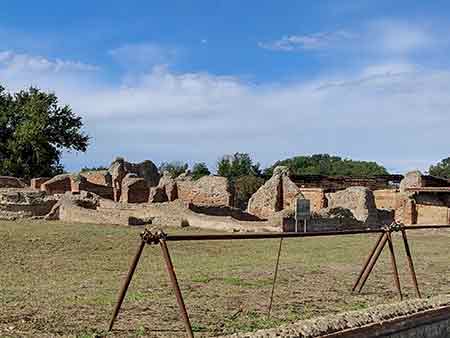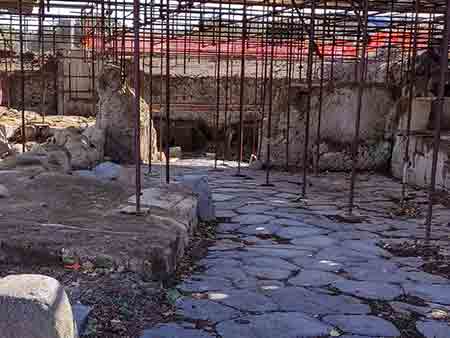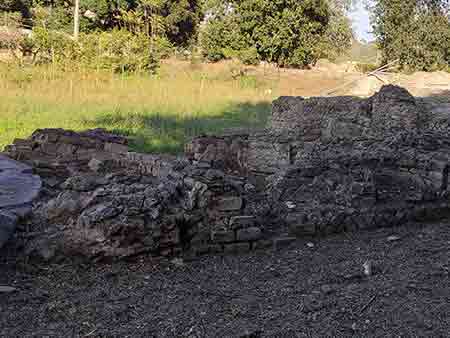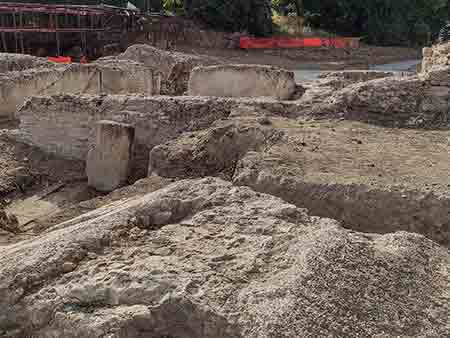Excavations of Cumae, ticket prices and location
Where are located the excavation of cumae in italy?
The archaeological park of Cuma is located on the region Campania coast, north-west of the city of Naples, facing the island of Ischia.
Street address: Via Monte di Cuma, 1 – 80078 Pozzuoli (NA)
What are the Archaeological excavations opening times?
Open: 09.00
Close: 1 hour before sunset.
Closed on Tuesday
How to reach the excavations of Cumae
by car
please open Google Maps to reach the excavation of Cumae
by public transport
In Montesanto Cumana Station take the train to Torregaveta and get off at Fusaro station. From here go to via Vanvitelli, the road in front of the park of the Casina Vanitelliana, the bourbon hunting cottage (2 minutes walking). So with the little house behind you, the stop is on the left side, near the Illiano tabacco store, where you can also buy BUS tickets. Here you can take the Archeobus Flegreo or the Miseno-Pozzuoli Scavi Cuma bus. Please ask to the driver how to arrive at the archaeological excavations of Cumae, maybe some bus lines could be change.
How much does the excavation of Cumae ticket cost?
TICKET: € 5
REDUCED TICKET: € 2 (citizens of the European Union between 18 and 25 years old)
CIRCUITO FLEGREO TICKET: € 10
CIRCUITO FLEGREO REDUCED TICKET: € 5 (citizens of the European Union between 18 and 25 years old)
Free for everyone under the age of 18
Buy the tickets or the Annual Pass
The Circuito Flegreo ticket is valid 2 days and allows you to visit:
- the ancient Roman baths of Baiae
- the Aragonese castle of Baiae and the archaeological museum of the Phlegraean Fields
- the Flavian Amphitheater of Pozzuoli
- the archaeological excavations of Cumae
tel: +39 081 804 04 30
The Acropolis of the archaeological excavations of Cuma
The acropolis, from the Greek Akros (high) and Polis (city), was the upper and fortified part of the town of Cumae, which also served as a lookout.
The cave of the Cumaean Sibyl: the legend
The legend tells de story of Apollo (Greek deity of sun) who was greatly in love with Sybil, a young virgin.
He wanted the young woman became his priestess, and in exchange he promised to give her everything she asked. So she filed for the immortality without the eternal youth and that was a huge mistake because over the years she became older and older, weak, until she vanished and just the voice remained of her.
How Sybil predicted the future?
Sybil listened attentively the requests from the people. Then She wrote the answers on some leaves that was mixed by the wind created by Apollo. So Sybil had to interpreted the future taking the leaves in a random order. The people did not always appreciate the response, because it was the word on air (in English means fallen on deaf ears).
The Byzantine tower of Cumae and the view of the islands.
After passing the cave of the Sibyl, turn left and climb the stairs, here one finds the Byzantine tower and the terrace with a breathtaking view overlooking the islands of Ischia and Procida.
The lower terrace and the temple of Apollo
After the terrace on the coast and walking for about one hundred meters on the right there is the lower terrace where one finds the remains of the temple of Apollo, the Greek god of the sun. From here there is a spectacular panorama and it's possible to admire part of the coast and the entire internal area, including the forum of the ancient city of Cumae, located in the lower side of the city.
Around the 4th century AD /CE, the city of Cumae became one of the most important Christian centers and the temple of Apollo was transformed into a church.
The temple of Jupiter of Cumae
In front of the lower terrace you can see the sacred way, a trail of stones, walk all along it and you will arrive on the upper terrace, where one finds the ruins of the temple of Jupiter, the king of the Greek gods. But after recent studies it is thought that this was the temple of Apollo.
In this area the baptismal font and 80 paleochristian tombs have been brought to light, dating back to the period when Cumae became one of the most important centers of Christianity. In fact, the temple, at that time, was transformed into a real Christian basilica.
Archaeological Park of Cumae, the forum and the necropolis
Another area of the excavations of Cumae is located in the lower part of the archaeological park and it's not accessible every day. Please follow the official page of the archaeological park of the Phlegraean fields to know when it's possible to visit it.
The forum of Cumae, the ruins in the lower part of the city
The Roman forum is the heart of the ancient city where commercial, political, religious and administrative activities were carried out.
At the entrance to the forum we immediately find a rectangular square with the remains of porticos in gray tuff and white stucco on all its sides. These constructions date back to various periods of the 1st century. B.C. / B.C.E. as can be seen from the remains found.
The Capitolium of the excavations of Cuma
In the square of the forum of Cuma one finds the remains of the capitolium, also called the temple of Jupiter Optimus Maximus, a sacred place dedicated to the Capitoline triad: Jupiter, Juno and Minerva.
In this temple the three large busts of the triad were found and it is believed that one of them, the statue of Jupiter, also called the giant of Cumae, is the same that was lacated in Plebiscito square during the aragonase time (1600 AD / CE). The statue of the giant, now exhibited in the gardens of the National Archaeological museum of Naples.
Archaeological Park of Cuma and the baths of ancient Rome.
In the excavations of Cuma, thermal buildings were also brought to light. This relax area was not a natural spas with sulphurous water that came out from the subsoil, as the rest of the Phlegreans Field, here the heat was powered by a wood oven and the heated water was channeled under the pavement and heated all the rooms.
After the square of the forum one finds the ruins of thermal baths of Cumae, were built in the 2ndcentury. B.C. / B.C.E. modified and expanded several times up to the 5th century. A.D. / C.E.
In the complex there was a gym, the frigidarium, for bathing with cold water baths, the tiepidarium, for baths in warm water, the sudatio, for steam baths, and the caldarium with three pools, for hot water and steam baths. Here we also find the old Domitiana, a road made up of stones that led to Rome.
The local market of the ancient city of Cuma
After the ancient Via Domitiana, we first find the remains of a small local market, then the path leads to the exit of the forum and the town. We are in fact, in front of the central gate of Cuma, the entrance to the city.
The necropolis of the excavations of Cumae
The necropolis, from the Greek nekros (dead) and polis (city), is the cemetery of ancient Cumae located outside the town, near the central gate.
So leaving the city we arrive at the necropolis of Cumae, the cemetery with various mausoleums. Here tombs from the Greek, Samnite and Roman periods have been found. The cremation was the technique used for the burial, or at least it was for the magior part of the tombs found and the ashes found were inside a small bronze cauldrons in turn inside blocks of white tuff with various kits of the deceased (pins, clasps, spindles, weapons, etc.), objects that make us understand the type and level of life of those people before they died.
The history of Cuma, a Greek colony
Cumae was a city of the Campania region. It was a historical and cultural city of the ancient world.
It was one of the oldest Magna Graecia colonies, maybe the first one. Founded in the 8th century BC (Maybe in 740 BC) during the Iron age. Then it was abandoned during the Middle Ages, around 1200 AD / CE.
The colonized land was very fertile, and the settlers immediately became farmers. They were also skilled maritime traders, so their political and economic power grew very quickly. They extended their territory until the Sorrento peninsula, colonising also the whole bay of Naples included the island of Procida and Ischia.
The Greek culture developed rapidly:
- The Greek Alphabet.
- The Sibyl of Cumae (Sibilla Cumana), the priestess of the oracle of Apollo (Greek god of the sun).
- The adulation of Greek deities: Zeus (King of the gods), Poseidon (God of the sea), Ares (God of war) etc. When the Roman empire conquered Cumae, the Greek gods were incorporated into Roman ones. Roma changed their name: Zeus became Jupiter, Poseidon became Neptune.
Timeline of Cumae history:
The first battle of Cumae in 524 B.C / B.C.E. against the neighboring peoples of Etruscans, from Capua, and their allies, Daunians and Auruncis. Cumae's location was perfect for economic expansion on the Mediterranean waters. Cumae won the battle.
The second battle of Cumae in 474 a.C. still against the Etruscans. This time Cumae was allied with Syracuse, a Magna Graecia colonies in Sicily. The naval fleet of Greek federates of Sicily and Campania regions defeated the invaders.
438 a.C. or 421 a.C. (uncertain date). The cumaeans was weakened by the last battle and because of that they were conquered by the Samnites (people from south-central Italy). Under this new domain, Cumae saved the Greek cults and customs.
Rome, in 338 BC / BCE extended its domination of the Campania region, and Cumae obtained the "civitas sine suffragio" (The empire gave Cumans Roman citizenship, but they could not vote).
The third battle of Cumae in 215 BC / BCE. The People of Campania region found a new alliance to conquer Cumae: the Carthaginians of Hannibal from northern Africa. This time the Cumaeans were allies with the Roman Empire. They defeated the invaders.
Cumae obtained in 180 BC /BCE the right to use the Roman language (the Latin language) in official documents.
Around 10 A.D. the Roman built Aqua Augusta (also called Serino Acqueduct). It was 96 km long and started in Serino's clean water source on the Terminio Montain, arrive in Bacoli (province of Pozzuoli) in a big Cistern named Mirabilis.
The Roman Civil War, from 44 to 31 AD /CE. It was a naval battle in the waters of Cuma. Octavian (also known as Augustus) against Sextus Pompey. There were no winners.
After these dates, Cumae became a quiet and peaceful place, where it became one of the most important Christian centers of the region of Campania.
After several centuries Cuma is repeatedly conquered by foreign peoples:
-
in 536 by the Byzantines,
-
in 542 by the Ostrogoths (Germanic people),
-
in 558 once again by the Byzantines,
-
in 717 by the Duchy of Benevento of the Lombards (Germanic people),
-
in 718 once again by the Byzantines,
-
in 900 from the Saracens of North Africa until the in 1207 when they were drive them out by Neapolitans.
From that moment Cumae was uninhabited. The whole coast became an immense quagmire, due to the silting up of the Clanis and Volturno rivers.
During the Second World War, the acropolis of Cumae was used as a bunker. From the top it was easier to use the cannons.
All the archaeological remains found in this area are exhibited in the archaeological museum of the Phlegraean fields located in the Aragonese Castle of Baiae.


